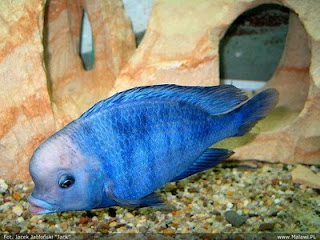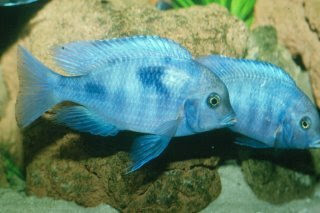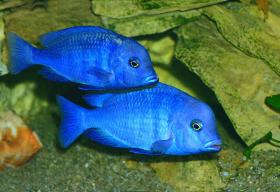
Also called the blue dolphin of Lake Malawi. A very beautiful fish with an excellent coloration with all grades of blue. "Very peaceful for an African, it will only chase other fish if provoked or when spawning". At least this is what should happen. However, my male C. moorii hasn't read any books so it doesn't behave like that. Very peaceful with most species it fights ferociously with the strongest fish in my tank, the Nimbochromis venustus. Very often you can see both of them with scars and missing scales. Once these fights begin all other fish stay at the tank corners leaving the center to the two gladiators, who may spend an hour chasing each other. Strange as it may sound the moorii is the hyperdominant fish in my tank (something that will presumable change when my Buccochromis nototaenia male reaches adulthood, now a 21 cm "baby").

The moorii will eat any cichlid food offered in big quantities. Provided with lots of space they will spend most of their time swimming around (you must provide them with swimming space). Grows fairly large and should be kept in large tanks only (>500 Lt). Males may exceed 20 cm in length (mine is already about that size) and their body shape calls for too much space. It takes a very long time for this fish to start spawning (almost two years), but when they do they are like a clock ! My pair spawns every 45 days. When trying to remove the carrying female to her one tank you should be very patient and avoid any moves that may frighten the fish. The female will readily spit the eggs in the tank which will be eaten by the other fish on the spot. If caught in a gentle way the female may spit the eggs in the net. After placing her to the new tank, drop the eggs in it. The female will pick them up after an hour or so. Since the fry can't survive with their egg sacks still on their bellies it is preferable to wait at least 14 days before netting the female. Thus, if the eggs are spitted the fry still has a good chance to survive.

Minimum tank size : 150 cm / 500 liters, Recommended tank size : 200 cm / 750 liters. Recommended combination : One male with three or more females in a 1.000 liter tank. Tankmates : large size haps. In a community tank, one female is enough. Lots of open spaces.

Close-up shot: 100 ASA film, 125 mm lens, f/11, 1/60 sec, auto-bellows, Sunpack flash unit (GN:36 at 1/8th setting) taped over the lens, shot from a distance of 20 cm. Flash head tilted slightly to avoid reflections from the glass. Hand-held camera - a really difficult one.






credit http://www.malawicichlidhomepage.com/haps/malawi_moorii.html
No comments:
Post a Comment